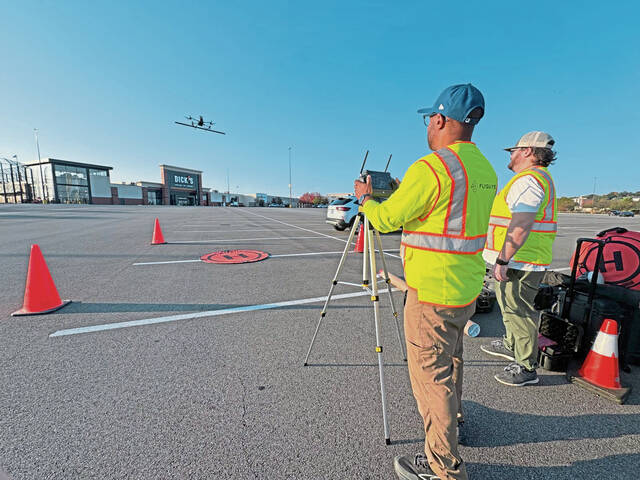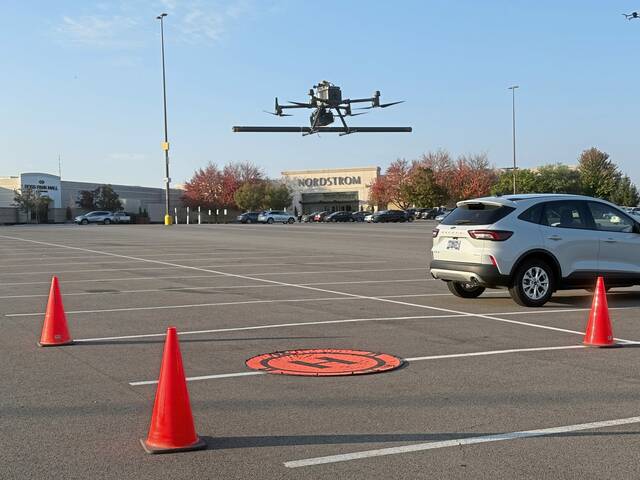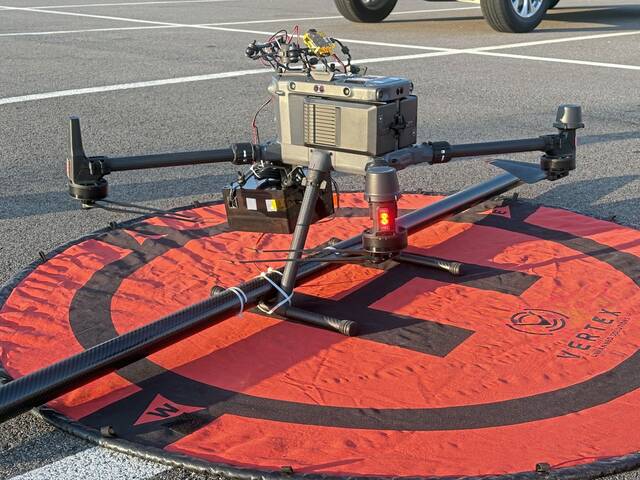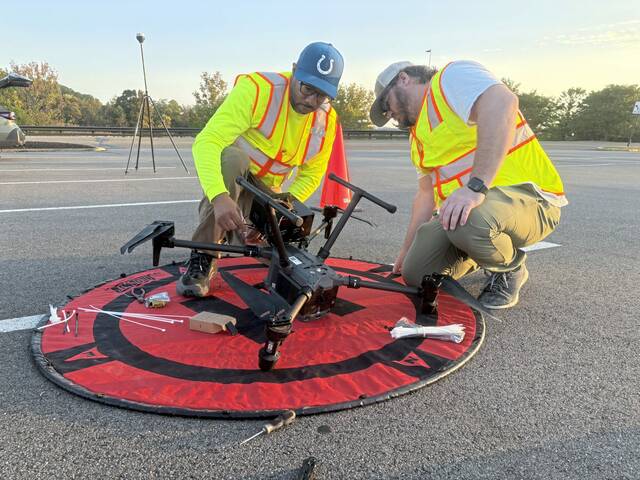Drone flown over Ross Park Mall in effort to find abandoned and orphaned wells
An effort to find abandoned and orphaned gas wells in parts of Southwestern Pennsylvania took to the sky Sunday morning over Ross Park Mall.
The flights, conducted before the mall opened, marked the start of field work to survey parts of Ross and Shaler along with areas of North Fayette and White Oak in Allegheny County and South Strabane and Charleroi in Washington County.
The project is being conducted by a coalition of government agencies, environmental groups and universities, with funding from the Bloomberg Family Foundation and Hillman Foundation.
Between 300,000 and 700,000 abandoned and orphaned gas wells are believed to be in unknown locations across the state. They are hazardous because they can leak methane, a potent greenhouse gas, and volatile organic compounds such as benzene, a cancer-causing neurotoxin, that contaminate the air, water and soil, said Patrice Tomcik, senior director of Moms Clean Air Force, one of the groups involved in the effort.
There also is an economic impact, as having a well on a property can lower its value, said Chris Whitlatch, a spokesman with the Environmental Defense Fund.
The goal is to find and plug them. Plugging them has an economic benefit by creating jobs for those who do the work, which Tomcik said has led to the hunt having bipartisan support.
A public meeting covering the search in Ross and Shaler was held in July in Ross. Another is coming up Tuesday evening at the North Fayette Community Center.
Ross Park Mall is being checked because it is among locations where complaints of gas odors could not be traced to a known source, Whitlatch said.
Numerous wells were drilled before state permitting started in the 1950s, he said. When areas such as Ross and Shaler were being developed, only local permits may have been needed, with developers not being required to map well locations.
“In fact, they probably didn’t know that wells were here,” he said, adding that wells can be on hillsides, under driveways and in backyards.
Beyond finding wells in this area, the project also is intended to test the technologies and processes so they can be scaled up and accelerated to find more, he said.
Tomcik was at the mall Sunday morning to see the drone flights begin.
“I’m excited for this with the amount of wells we have in Western Pennsylvania,” said Tomcik, who lives in Adams Township in Butler County. “It’s great to have this technology moving forward. It will give us a lot of answers where some of those wells are and how much they’re leaking.”
The drone carried a magnetometer, which can detect the distinct vertical metallic shaft of a well, and methane sensors. Flying at a height of 131 feet and a speed of 32 feet per second, it covered the entire mall and its parking lots with five preprogrammed flight plans lasting between two and eight minutes, said Phil Franklin of Lafayette, La., a drone pilot with Flyguys, a national data capture company working for Sawback Technologies of Alberta, Canada, on the project.
The drone can detect wells up to 70 feet underground, Sawback founder Neil Keown said.
It was not immediately known whether any wells were found. The drone’s data has to be downloaded and analyzed, which can take up to a week, after which it is given to the state Department of Environmental Protection, which sends inspectors out to confirm the findings, Whitlatch said.
The drone has been found to be extremely accurate when searching for wells in rural areas. Over state gamelands in Clarion County in October 2024, all of its detections were confirmed except for those in locations that were not accessible.
While the parking lot’s asphalt is not an issue, how well it will work under the mall was less certain because of the building’s structural steel and other metal equipment, Keown said.
“No one’s ever tried,” he said. “We’re quite excited about it.”
All of the drone flights are scheduled to be finished by Sept. 30, Whitlatch said. In addition to Ross, flights were scheduled Sunday in Charleroi.
Flights are scheduled to begin Monday and Tuesday in North Fayette, followed by South Strabane on Wednesday. White Oak is scheduled for Thursday.
The team will return to finish Ross on Friday and then move to finish North Fayette for the rest of the day Friday and Saturday. They will be in Shaler on Sept. 29 and back in White Oak on Sept. 30. The schedule is subject to change due to weather.
Neighborhoods also will be surveyed by vehicles equipped with methane sensors, and that is expected to be finished in all areas by the end of September. That will be followed by walking surveys with backpack magnetometers in early to mid-October.
Results of the effort are expected to be made publicly available by February, Whitlatch said.
Residents don’t need a high-tech drone to help in the effort to find abandoned and orphaned wells. Anyone who believes they may have found a well, whether on their own property or while hiking, can report them to the state online.
A state map of known gas wells also is available online.
“Anybody can help in this process so we can get a handle on it,” Whitlatch said. “Even if you find one that’s already in the database, no harm, no foul.”
Brian C. Rittmeyer, a Pittsburgh native and graduate of Penn State University's Schreyer Honors College, has been with the Trib since December 2000. He can be reached at brittmeyer@triblive.com.
Remove the ads from your TribLIVE reading experience but still support the journalists who create the content with TribLIVE Ad-Free.





